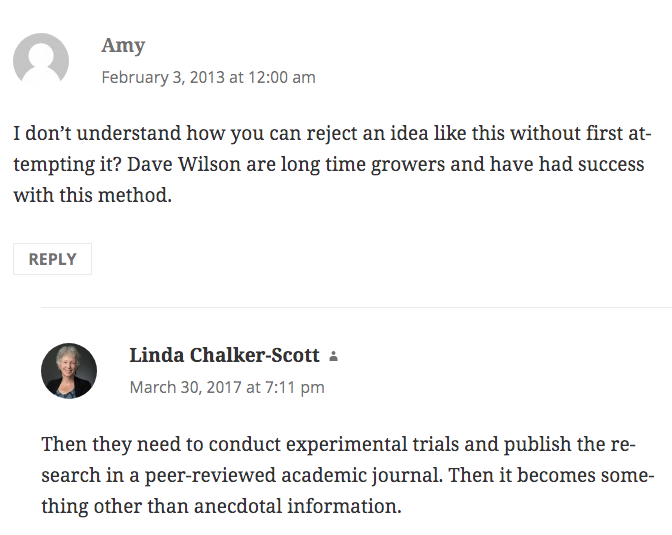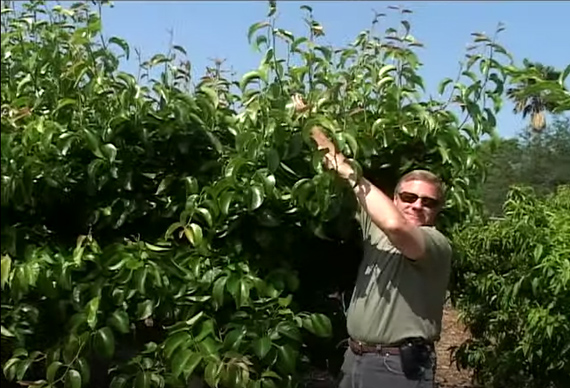It’s no secret that I am a fan of experimentation, particularly with fruit trees. The idea of backyard orchard culture is fascinating to me and I have enjoyed watching the Dave Wilson Nursery videos on the topic, as well as reading Ann Ralph’s book Grow a Little Fruit Tree. One of the practices discussed in both is multi-planting fruit trees; that is, planting two, three or even four fruit trees in a single hole.
Sadly, I have now been informed that this is a terrible idea:
“I’m sorry, but this is just asking for trouble down the road. Readers of this blog know that root systems extend far past the drip line, and that roots from different trees are going to compete with one another. You’ll end up with three unhappy trees, all jostling for space and resources, just like kids in the back seat during those long car rides.
But wait! you might say. There’s research on high density tree planting, and it’s been shown to increase fruit yield on a per acre basis!
Yes, in fact there is a lot of planting density research on many different species of fruit trees. What’s considered by researchers to be “high density” varies, but it rarely exceeds 2698 trees/acre (6666/ha for our international readers). Optimal and sustainable levels of high density planting are also variable, as they depend on not only species but rootstock and the crown architecture; 1214/acre (3000/ha) might be a mid-range number. This can be converted to a per-tree requirement of 36 sq. ft. or a 6’x6’ planting area.
How does this compare to the 12-15” recommendation given earlier? If we’re generous and use the 15” recommendation, this translates to 6.25 sq. ft. per tree or 6970 trees/acre. The 12” recommendation would lead to a whopping equivalent of 10,890 trees/acre. (And no, it doesn’t matter if you’re using dwarfing rootstock or not; most of the higher densities in the literature are for dwarfing rootstocks.)
You don’t have to be a math whiz to see that these densities are totally out of line with reality. Sure, you can probably keep overcrowded trees alive with lots of water and fertilizer, but they’ll be under enough chronic stress so that pests and disease might take hold, and fruit production will likely be poor. And it’s about as far from a sustainable practice as you can get.”
But… but Dave Wilson!

Ah, that’s the thing, isn’t it? We need peer-reviewed science! Scientists can guide us with their collective wisdom in how we should plant trees in our backyard. Because scientists are way smarter than you are and way less fallible. As we can see here, scientists are doing a bang-up job running studies these days:
“Science is facing a “reproducibility crisis” where more than two-thirds of researchers have tried and failed to reproduce another scientist’s experiments, research suggests.
This is frustrating clinicians and drug developers who want solid foundations of pre-clinical research to build upon.
From his lab at the University of Virginia’s Centre for Open Science, immunologist Dr Tim Errington runs The Reproducibility Project, which attempted to repeat the findings reported in five landmark cancer studies.
“The idea here is to take a bunch of experiments and to try and do the exact same thing to see if we can get the same results.”
You could be forgiven for thinking that should be easy. Experiments are supposed to be replicable.
The authors should have done it themselves before publication, and all you have to do is read the methods section in the paper and follow the instructions.
After meticulous research involving painstaking attention to detail over several years (the project was launched in 2011), the team was able to confirm only two of the original studies’ findings.
Two more proved inconclusive and in the fifth, the team completely failed to replicate the result.
“It’s worrying because replication is supposed to be a hallmark of scientific integrity,” says Dr Errington.
Concern over the reliability of the results published in scientific literature has been growing for some time.
According to a survey published in the journal Nature last summer, more than 70% of researchers have tried and failed to reproduce another scientist’s experiments.”
Pardon me if I trust nurserymen more than I trust “peer-reviewed science” and academic journals.
The original article at GardenProfessors completely misses the point of backyard orchard culture. It’s not about commercial planting of trees mere inches apart over acres of ground. It’s about putting multiple trees together to cause deliberate dwarfing, to increase pollination, to extend the harvest season and to add more fruit variety to a small backyard garden space.
Yes, it’s experimental. Yes, it’s not a standard practice. But the “anecdotal” evidence, as usual, is more useful than the word salad oracles the academicians deliver in their esoteric journals.
By the power invested in me by the renowned, peer-reviewed academic journal The Survival Gardener, I pronounce you all scientists. Go ye forth and experiment.
Today I will be multi-planting some plums and pecans, and maybe some other things too. FOR SCIENCE! And everyone on YouTube can peer-review how it turns out.
See you there.


16 comments
Preach it!
It’s a whole lot easier to make sure three little trees in the backyard have enough fertility and watering to keep them happy than to do it on a commercial orchard scale. If you wait for peer review on small scale strategies, you’re going to be waiting a long, long time because research funds largely are centered on large scale agriculture. The nurseryman is the superior source and the backyardist is the one doing the research.
Absolutely. A++ comment.
You’re mad.
I like it.
It won’t work if it isn’t peer-reviewed!
Yet somehow, we went from huddling in caves to the industrial age without peer review.
Your learn by doing approach is right up my alley.
I multiplant all kinds of things, knowing I can cut down or back anything I decide to edit out.
I also find volunteer trees multiplanting themselves, and edit those growths accordingly.
What commercial orchard would even do that?
Ah, but I’m not a danged orchardist, I’m a freaking gardener!
My goals and tools are family and community scaled, at the largest.
Even if I had enough room for a fraction of a conventional orchard, what the heck would I do with the results of 20 trees producing the same thing at the same time?
Last year I got 50 lbs of pears from one totally untended trees and that was too much for my own household to absorb.
Dave, I planted 2 more avocados next to my existing one today. Triangle shape four feet apart. Deep mulch heavy pruned the existing one and my son’s have dubbed it avocado island. Thanks for inspiration to do it! Hopefully I can catch you on your next south florida trip and talk. Have a great day!
Thanks for doing your part for science!
Amen! This is exactly the problem with deductive reasoning. Experienced gardeners have been using this method with great success for years, yet this article talks about how it CAN’T work because “I did some math and my results say so.” Reminds me of that story you told once about some out-of-towners in Florida who noticed a banana tree growing in someone’s yard, and one of them said, “What a great banana tree! It’s too bad they won’t grow here.” So what if you saw it growing here? The USDA plant hardiness map says it won’t grow here! Who are you going to believe, the USDA, or your lying eyes?
This is everywhere now. It doesn’t matter how many hundreds of people use the internet to talk about an experience they had, say, with a certain medical treatment, for example, and want to share their experience with others. Some people will dismiss all these claims as “anecdotal evidence,” which means they’re worthless, and point out that the peer reviewed papers that are cited by the scientists and politicians quoted in mainstream media say that those experiences aren’t happening, therefore all those people on the internet must be liars who are trying to get attention. Because we all know that only the most noble scientists and politicians get to speak their mind on mainstream media, whereas only alt-right wingnuts and trolls and flat-earthers use the internet, so we should of course trust only the former, and ignore all these uncredentialed nobodies. They’re probably just Russian spies anyway, trying to trick us into using unsustainable orchard planting methods so we’ll decimate our fruit production over the long term, thus slowly chipping away at our nutritional resources until our soldiers are weak and sickly, at which point Putin will launch his invasion.
Omg. Your reply is hilarious. “Chipping away at our nutritional resources!” Bahahahhaa. Thank you for the laughs this morning. Right! I’ll peer review these un-scientific statements anytime. Thank you for this discussion. I’m going to do this with my jujube trees.
Can you keep pecan trees little the same way you can with fruit trees? I’m really curious because I miss the pecans from my family’s yards in Texas. But pecans are just not grown where I live even though I can’t think of a reason why.
I don’t know, but it’s worth trying.
Waimea Nurseries ( one of New Zealand’s largest fruit tree growers) advocates ‘ family planting ‘ – up to four trees planted between 45-90 cm apart , pruned to leave outward branches and hey presto a fruit forest !
THEY HATE SCIENCE
[…] In the past, I’ve written about how you can plant more than one tree in a hole (and shot down some snotty “scientists” who say you shouldn’t). […]
[…] In the past, I’ve written about how you can plant more than one tree in a hole (and shot down some snotty “scientists” who say you shouldn’t). […]
Comments are closed.